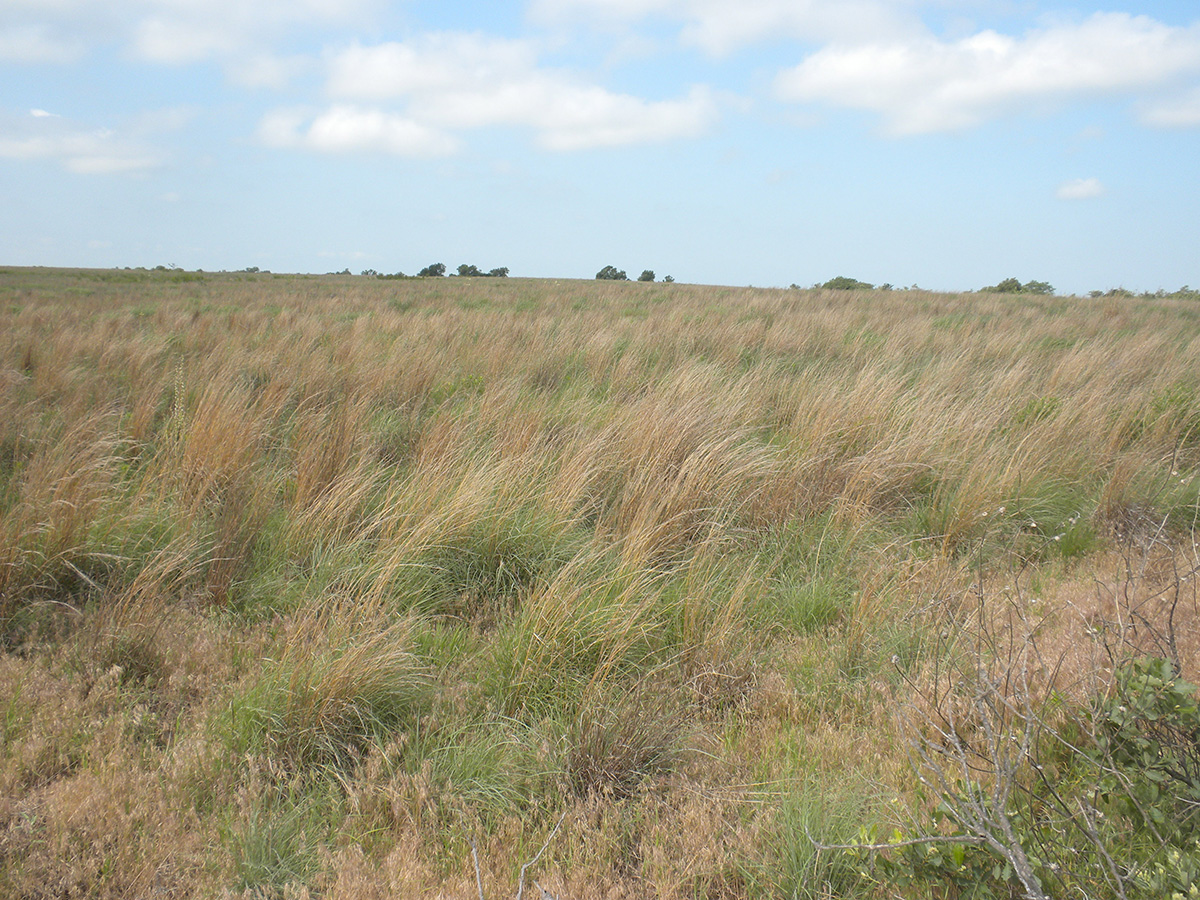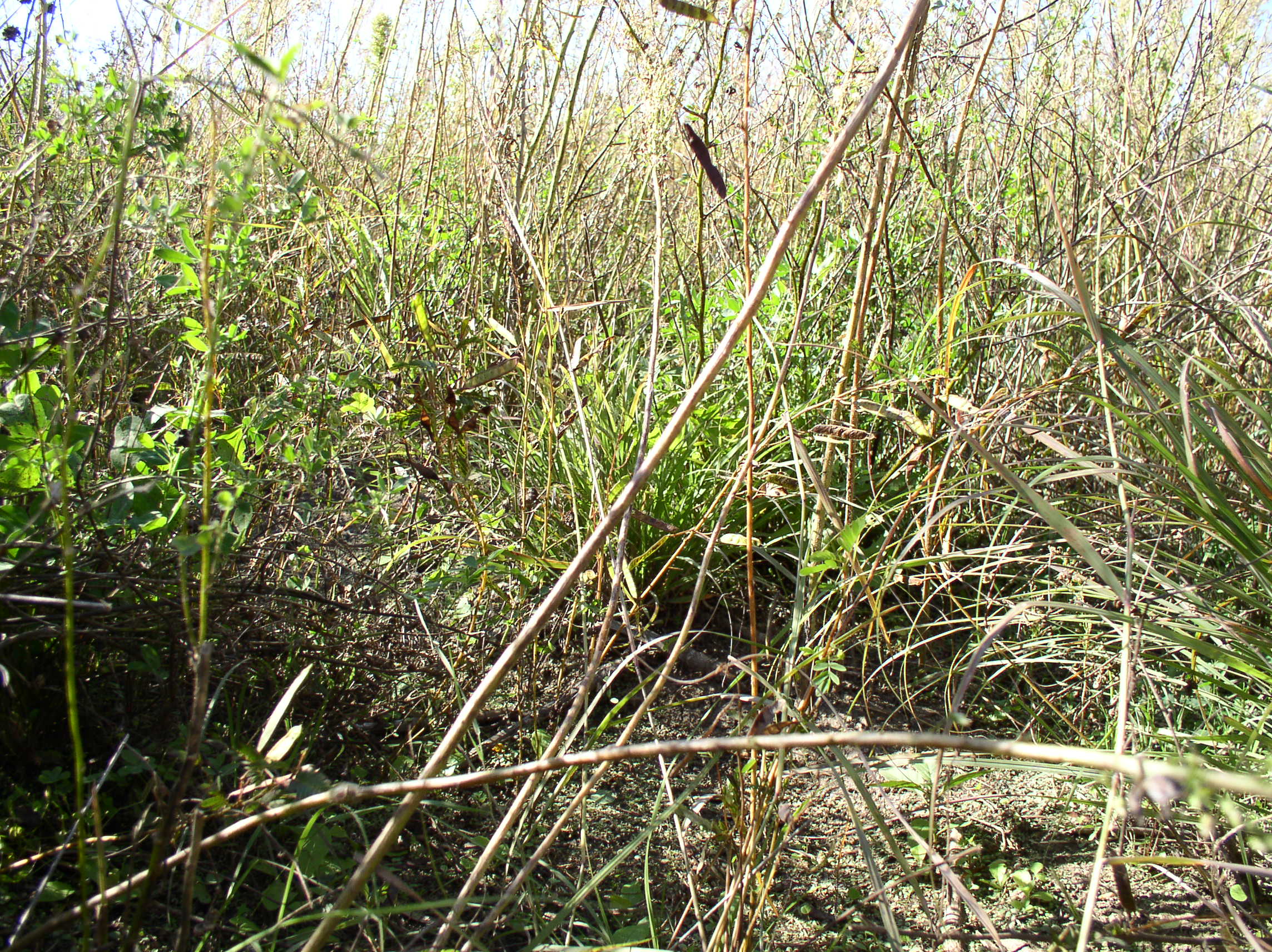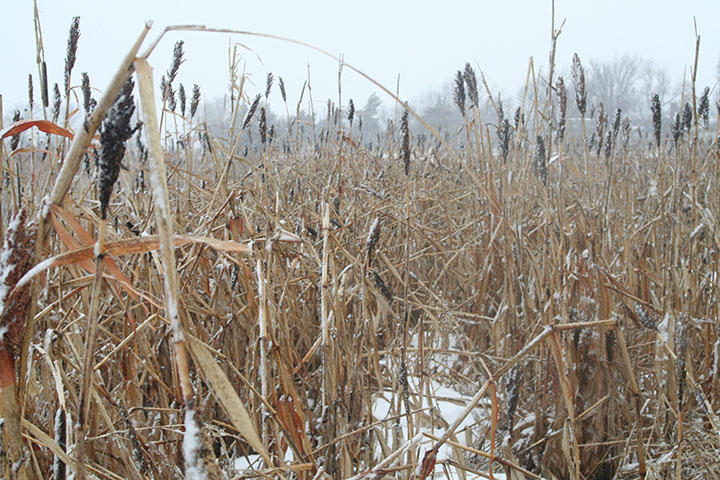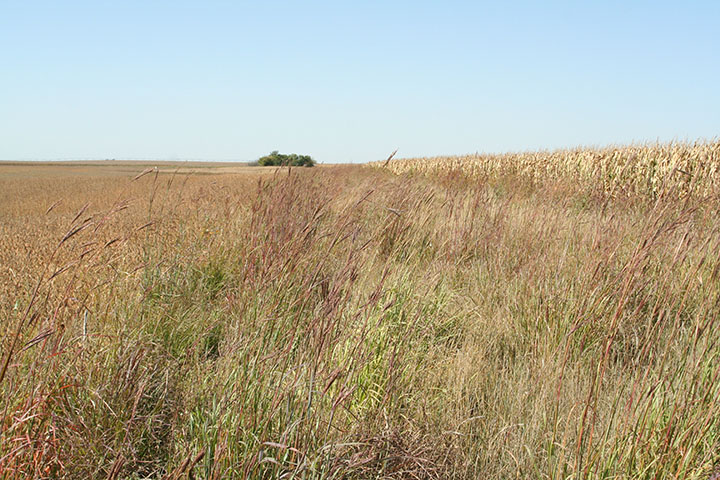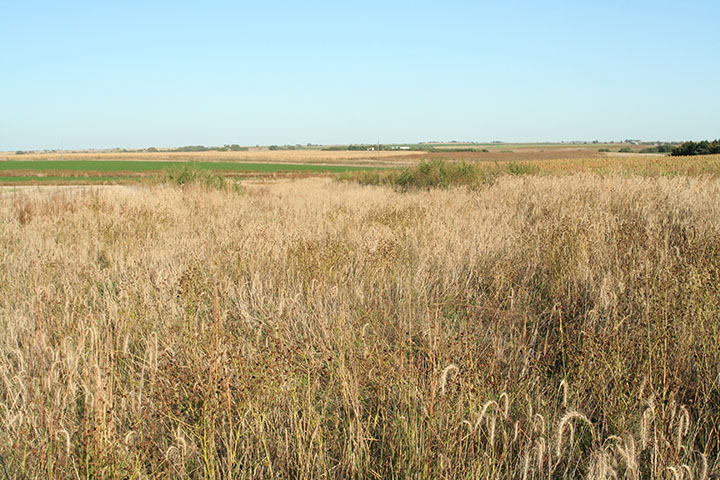The Ring-Necked Pheasant in Oklahoma
The ring-necked pheasant (Phasianus colchicus) is one of the most popular upland game birds in the central and northern regions of the United States. This species, which is native to China, was first released into the U.S. in the late 1850s. These initial stockings failed, but a subsequent release into the Willamette Valley of Oregon in 1881 succeeded and soon the pheasant began to be successfully introduced across the nation. Pheasant stocking started in Oklahoma in the 1920s, and by 1948, there was an open season in a few northwest counties. The ring-neck has a high resistance to disease and parasites, is adaptable, a strong flyer and excellent table fare. These traits have made it very popular with hunters. During 2009, nearly 19,000 hunters harvested more than 114,000 pheasants in Oklahoma. Pheasants are found in areas with grain crops with adjacent permanent cover such as dense grass, wetland margins and shelterbelts.
Description
The males are most recognized for their showy plumage. Their head and neck are iridescent blue-green or purple with a bright white collar. It is this collar that gives the species its name. The males, also called cocks or roosters, may weigh more than 2 ½ pounds and have bright red patches of bare skin on their cheeks, which form the wattles below the eyes. Males have multiple hues and patterns on their body and wing feathers. Depending on the date of hatch, juvenile roosters can be fully colored or have barely any color by fall. Adult roosters molt in the summer but are fully colored by early fall. Roosters have a spur located on the legs between the foot and knee. Spurs can vary from just a nub on a young bird to more than ¾ inch on an adult male. Spurs that are dull colored, soft pointed or blunt belong to juvenile birds. Black, shiny and sharp pointed spurs belong to mature birds. Females, or hens, lack the coloration of the male. They are mottled brown with small black spots on their back. Their tail is pointed with black barring and is shorter than the roosters’ tail, which can be greater than 20 inches. Hens weigh approximately 2 pounds. This muted coloration is an adaptation to being a ground nesting bird, to limit detection of the hen by predators while she is incubating her nest. Ring-necked pheasants are nonmigratory resident birds. They are found in areas with abundant grass cover mixed with agricultural grain crops. Individual birds will typically range less than a square mile daily under optimum habitat requirements, but some birds will roam further to satisfy requirements. Pheasants are found in heavy cover when roosting or loafing but will venture into open fields when feeding. They are swift runners. Only flushing when threatened, pheasants rise with short and rapid wing beats and fly until locking their wings and gliding into protective cover. They normally fly about 30 mph to 40 mph, but can fly faster when pursued.
General distribution of the ring-necked pheasant in Oklahoma.
Pheasants are one of the most popular game birds in Oklahoma and the U.S. (Photo by Roger Hill, courtesy of Pheasants Forever)
Life History
Breeding usually begins in early spring when the days become longer (April), but they continue to breed through July. Pheasants are polygamous; thus, one rooster will mate with many hens. The male establishes a “crowing territory” and the hens establish a nest site where suitable cover exists. Nests are located in shallow depressions on the ground and are lined with grass and forbs. Hens will lay 10 to 12 rich olive brown or green buff eggs at a rate of one per day. Two hens may use the same nest, resulting in large clutches. Nests are often destroyed by farm machinery, flooding or predators. Hens may abandon a nest but will usually try to re-nest and produce a second clutch of eggs. Nest success averages 40 percent to 60 percent. After an incubation period of 23 days, chicks are hatched. They are precocial and can walk from the nest and begin to forage immediately. Chicks are able to run within minutes of hatching and develop quickly from feeding upon a protein-rich insect diet. They are able to fly short distances within 7 days of age. They are unable to regulate their temperature for the first few days of life and are dependant on the hen who will brood them. During this period, chicks can die of exposure during periods of wet, cool weather. Chicks remain with the hen for up to 7 weeks. Hens will use a “cripple bird” act to lure predators away from chicks. The hen attempts to lead the chicks into areas with abundant insects (i.e. forb rich habitat). At 7 weeks of age, young pheasants molt their juvenile feathers and begin to develop adult plumage and coloration. Chick survival averages 50 percent. The average life span for male ring-neck pheasants is 10 months; females live approximately 20 months. However, this varies considerably based on the quality of habitat and the severity of winter weather. In some years, more than 90 percent of adult pheasants survive the winter, but in other years it can be as low as 20 percent survival, especially in poor habitat.
Food/Water
Both adult pheasants and chicks will eat insects such as grasshoppers, crickets, leafhoppers and caterpillars during the spring and summer months. Waste grains of crops such as wheat, sorghum, corn and sunflowers are readily used in the fall and winter. Seeds from native forbs and legumes (and some grasses) such as ragweed, sumpweed, native sunflower and foxtail are also important fall and winter foods. Green vegetation—including grasses, native legumes and alfalfa—are consumed year-round when available. A pheasant’s diet will provide an adequate amount of water, thus ponds and other water sources are not needed, although they will be utilized if available, especially during periods of drought.
Habitat Requirements
Pheasants utilize grass fields consisting of big and little bluestem, Indiangrass, side oats gramma, switchgrass and native forbs for nesting. Cover such as dense grasslands and Conservation Reserve Program (CRP), shelterbelts, overgrown road ditches and fence rows, field edges and corners, and shrubby odd areas are all utilized for winter cover. Various agricultural practices impact nesting cover, winter cover and the pheasant’s diet. Practices such as no-till farming, strip cropping, field buffers, delayed haying and low to moderate cattle stocking rates are beneficial to pheasants. Additionally, minimizing the use of herbicides and pesticides is beneficial. CRP land is highly preferred habitat for pheasants—particularly for nesting and winter cover—but can provide all habitat requirements, including brood rearing cover, if managed correctly. Shelterbelts are used during severe winters. Pheasant habitat can be broken into three broad categories, which are nesting, brood rearing and winter habitat.
Nesting
Nesting cover is often limiting for pheasants, particularly in areas with intensive farming. Pheasants nest in dense grass cover. As pheasants nest early in the summer, it is important that residual grass cover remain from the previous growing season. Thus, some areas should not have been hayed or heavily grazed during the previous season. Most pheasants have nested by mid July, although May and June is the primary nesting period. To maximize pheasant nesting habitat, avoid disturbance to nesting areas as late as feasible into the summer. Consider maintaining at least 10 percent of your property in good nesting cover. However, the more nesting cover present, the more pheasant reproduction you can expect. If possible, nesting cover should be arranged in large blocks, preferably of at least 40 acres to reduce predation of pheasant nests. Alfalfa can provide good nesting cover; unfortunately, it can have a negative impact on nesting success as the first cutting of alfalfa hay usually occurs during the peak nesting season, which will destroy nests. When haying grass, consider raising the mower to a height of 10 inches so birds can still nest in that area. When haying alfalfa, consider leaving 50-foot buffers around the edge of the field for nesting areas. Where crops are grown, simply maintaining grassy field borders and corners will provide at least some nesting habitat. Although not a substitute for permanent native grass cover, winter wheat in rotation can provide early nesting cover as it is usually in large blocks, is dense during the nesting season, and is typically not harvested until early summer. The use of stripper headers also leaves taller wheat stubble for additional nesting attempts and brood-rearing cover in the summer. Additional acreage of grass, such as CRP fields or native pastures, also will provide nesting cover. In native pastures, make sure that your stocking rates are low enough that dense grass cover exists during April to July. Plan prescribed fire so at least one-third of your potential nesting cover is unburned during any year.
Dense grass cover such as this native CRP field provides excellent nesting habitat for pheasant.
Brood Rearing
Brood rearing habitat is crucial for pheasant reproduction. Pheasant chicks feed almost exclusively on insects during the first few weeks of life. To increase the abundance of insects, a site should have abundant forbs and legumes. Some forbs and legumes complete their life cycle early in the season, others late. Also, precipitation influences which plants are abundant from year to year. Thus, it is important for brood habitat to have a diverse plant community, so that throughout the summer there will be insect and seed bearing plants present. Some agricultural plants, such as alfalfa, have high numbers of insects as well, assuming that pesticides are not used and haying is not conducted during the brood rearing season (May to August). Harvested winter wheat can provide brood rearing cover provided the stubble is more than 10 inches, remains undisked through the summer, and herbicides are not applied to control summer weeds. Wheat stubble and annual forbs provide cover, insects, and seed for pheasant adults and chicks. The structure of the brood habitat also is important. It should be fairly open at ground level so as not to impede chick movement. There should be overhead cover to shield from the sun and predators. Nesting habitat and brood habitat can exist on the same area assuming grass, forbs and legumes are all present. To maintain quality brood habitat, periodic disturbance is necessary as grassy areas tend to become thick with litter accumulation over time. This not only impedes chick movement, but also forb and legume (and thus insect) abundance declines. To stimulate good brood habitat, use prescribed fire, strip disking, inter-seeding forbs and legumes, cattle grazing or a combination of these practices every three years to five years. Attempt to have about one-third to two-thirds of your property managed for brood habitat to maximize pheasant numbers.
An example of good pheasant brood cover. While there is overhead cover, the ground is fairly open to allow movement of chicks. Also notice the abundance of forbs which will harbor the insects that chicks require (Photo by Jason Sykes, Pheasants Forever).
Winter
Winter cover is important to maintain high overwinter survival. Most winters in Oklahoma are fairly mild, but we do see occasional ice and snow storms with prolonged cold. During these winters, dense cover adjacent to food resources becomes critical. Areas of dense herbaceous and woody vegetation provide predator protection and thermal cover. During most years, areas of thick grass (such as switchgrass) or cattails around playas will provide sufficient winter cover. Windbreaks and shelterbelts containing conifers will be used in the most extreme winter weather. However, trees and other tall vertical structures are very detrimental to some native grassland birds such as the lesser prairie-chicken. Thus, shelterbelts consisting of tall trees should be minimized in areas with abundant native grasslands and the lesser prairie-chicken. Instead focus on dense grass cover (that can also serve as nesting habitat in the spring), cattails and shrubby cover such as sand sagebrush and sand plum. If you plant shelterbelts, utilize shrubby species that will not attain tall heights and only use plants that are not invasive. While eastern redcedar provides good thermal cover for pheasants, it is highly invasive in grasslands and requires periodic fire to prevent grasslands from becoming woodlands. Consider planting plums, dogwoods, and other dense native shrubs instead. Abundant food near this dense cover is important to minimize exposure of birds to weather and predators as well as to minimize travel between cover and food. Fall and winter is when grain crops such as corn and milo are used heavily. These high energy foods can be important for overwinter survival during severe winters. Pheasants also consume native forb and legume seeds during the winter months. No more than 5 percent to 10 percent of the landscape needs to consist of dense winter cover for pheasant.
Food plots are rarely needed in agriculturally dominated areas and should only be implemented after all other habitat issues have been addressed. The food plot above, composed of both grain and forage sorghums, provides standing food above the snow and excellent winter cover because the taller forage sorghums fall over and lodge, similar to a cattail dominated wetland (Photo by Jason Sykes, Pheasants Forever).
What Can You do to Help Your Pheasant Population?
- Establish buffer zones around ditches, ponds, and wetland areas. These buffers should be at least 30 feet, although buffers of 60 feet are preferred.
- Delay mowing and haying until after nesting season which is generally July 15 for Oklahoma. If you must hay before this date, install a flushing bar (see NREM-5006) on your equipment to reduce hen pheasant mortality. Cut hay beginning in the middle of the field working outward to allow pheasants to escape the field through the uncut grass. Avoid mowing roadsides and ditches if possible.
- Establish buffer zones around agricultural fields. This will enable pheasants to use agricultural fields with limited exposure to predators. Some birds will nest within these areas as well. These buffers should be at least 30 feet, although buffers of 60 feet are preferred. Do not disk or cultivate field corners in center-pivot irrigated fields.
- Leave brushy fence rows, windbreaks and other uncultivated areas for protection and travel lanes.
- Plant terraces and waterways in native bunch grasses such as little bluestem, big bluestem, Indiangrass or switchgrass. Avoid dense thatch grasses such as Bermuda or invasive species such as Old World bluestem and weeping lovegrass.
- Periodically disturb grasslands with prescribed fire or grazing to stimulate forbs. This will provide food for pheasants. This is particularly important for CRP fields, which often become very dense. In these fields, which have already been cultivated in the past, strip disking may also be used to stimulate forb growth. Consider disturbing only half of the field each year to allow for nesting cover. Contact your local Farm Service Agency (FSA) and Natural Resources Conservation Service (NRCS) offices before implementing any practice on land enrolled in CRP.
- Maintain nesting cover in grass fields. Pheasants use the previous seasons’ perennial grass cover for nesting. Thus, do not allow cattle stocking rate to be so high that no residual grass cover remains. Rotational grazing systems should have a long rotation length to ensure quality nesting cover. Grass height should be 10 inches or greater. A good rule of thumb to determine if you have good nesting cover is throw a football into the field around mid-April. If the football disappears you have adequate nesting cover.
- Leave a few outside rows of existing crops standing near field edges. This is particularly valuable for grains crops such as corn, sorghum, and wheat.
- In areas deficient in forbs, small linear food plots can be planted. Alfalfa is a top choice for Oklahoma as it is drought tolerant, persists for multiple years, harbors high insect abundance, and is not invasive. Two or more annual grain food plots can also be rotated such that one gets planted while the other is fallow (volunteer grain and native annual forbs will establish.).
- Windrows and tree rows can be beneficial to pheasants during extreme winter weather. However, the presence of tall trees within native prairie is very detrimental to many native wildlife. Some species of wildlife, such as the lesser prairie-chicken, will avoid tall vertical objects such as trees. During most winters in Oklahoma, dense CRP fields are sufficient for wintering birds.
- Minimize the use of pesticides and herbicides. Pheasants require insects and forbs.
- Utilize no-till farming so pheasants can feed on waste grain. Additionally, the stubble provides some cover for feeding birds. In conventionally tilled farming, delay tillage until spring.
Field buffers around crop fields increase the carrying capacity of the land for pheasants. Wider buffers (more than 60 feet) planted to diverse mixes of native grass, forbs, and legumes can be used by nesting hens and broods. Additionally, birds can forage in the adjacent crop residue during the winter especially if native shrubs are present in the buffer (Photo by Jason Sykes, Pheasants Forever).
This waterway, was planted to a mixture of native warm season and native cool season grasses, such as switchgrass and big bluestem, rather than introduced grasses. After establishment, it will provide good nesting cover for pheasants and excellent winter and travel cover as it provides a lot of edge for pheasants to feed in adjoining crop fields while still being close to cover (Photo by Jason Sykes, Pheasants Forever).
| Cover Type | Nesting Cover | Brood Rearing | Food Value | Winter Cover |
|---|---|---|---|---|
| corn | poor | fair | excellent | fair |
| winter wheat | good | good | good | poor |
| grain sorghum | poor | fair | excellent | excellent |
| forage sorghum | poor | excellent | good | excellent |
| alfalfa | good | excellent | excellent | poor |
| native grass with forbs and legumes | excellent | excellent | good | good |
| weeping lovegrass | good | fair | poor | good |
| old world bluestem | fair | fair | poor | fair |
| grassy waterway | fair | fair | poor | fair |
| roadside ditches | fair | fair | fair | fair |
| abandoned farmstead | good | good | fair | good |
| shelterbelt | fair | fair | fair | excellent |
| fenced playas and ponds | excellent | good | fair | excellent |
| weedy corners and buffers | good | excellent | good | good |
Notes:
- Winter cover ratings for annual grains (corn, winter wheat, grain sorghum and forage sorghum) are for crops left standing. Harvested crops with standing stubble would rank lower.
- Nesting cover rating for alfalfa is based on unhayed alfalfa. Alfalfa fields hayed during April-June would be rated as poor.
- Brood rearing and food rating for native grass assumes there is a good mix of forbs and legumes and that periodic disturbance is taking place to produce food plants and decrease ground litter.
For more information on pheasant biology, habitat management, available programs to manage your property, or to speak with the closest biologist, please contact Pheasants Forever at www.pheasantsforever.org or call (877) 773-2070.



